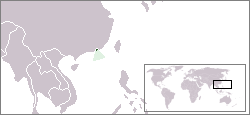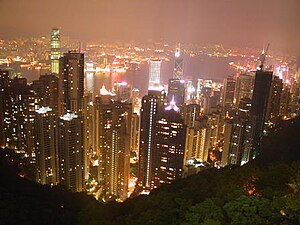| Revision as of 09:01, 9 December 2004 view source213.38.188.195 (talk) →Politics← Previous edit | Revision as of 09:05, 9 December 2004 view source 213.38.188.195 (talk) →EconomyNext edit → | ||
| Line 87: | Line 87: | ||
| In early ], the local economy was hit hard by the outbreak of ] (SARS). On ], ], the Mainland and Hong Kong ] (CEPA) was signed. CEPA allows Hong Kong service providers in 18 areas to enter the mainland market at least one year ahead of their foreign competitors. The arrangement provides a platform for Hong Kong professionals to practice on the mainland and also allows Hong Kong permanent residents to set up individually owned ] in ] Province. | In early ], the local economy was hit hard by the outbreak of ] (SARS). On ], ], the Mainland and Hong Kong ] (CEPA) was signed. CEPA allows Hong Kong service providers in 18 areas to enter the mainland market at least one year ahead of their foreign competitors. The arrangement provides a platform for Hong Kong professionals to practice on the mainland and also allows Hong Kong permanent residents to set up individually owned ] in ] Province. | ||
| stanley smells | |||
| On ], ], the ] was started to allow travellers from some cities in mainland China to visit Hong Kong on an individual basis. As a result, the ] is booming once again. | On ], ], the ] was started to allow travellers from some cities in mainland China to visit Hong Kong on an individual basis. As a result, the ] is booming once again. | ||
Revision as of 09:05, 9 December 2004
The Hong Kong Special Administrative Region or Hong Kong (香港, Cantonese IPA: hœŋ1gɔŋ2, Jyutping or Penkyamp: hoeng1 gong2, Hanyu Pinyin: Xiānggǎng, Wade-Giles: Hsiang-kang, meaning Fragrant Harbour), is one of two Special Administrative Regions (SARs) of the People's Republic of China (the other is Macao), consisting of a small peninsula attached to China's southern coast and 236 islands in the South China Sea, of which Hong Kong Island is the second largest and Lantau the largest.
Under the policy of the 'One Country, Two Systems', Hong Kong enjoys a considerable degree of autonomy from the Mainland, as well as continuing to have its own legal system, currency, customs immigration authorities, and even its own rule of the road, with traffic continuing to drive on the left, for example.
| |||||
| National motto: None | |||||
 | |||||
| Official languages | Chinese (Cantonese spoken de facto) and English | ||||
| Capital | Victoria City | ||||
| Chief Executive | Tung Chee-hwa | ||||
| Area - Total - % water | (Not ranked) 1,102.15 km² 4.6% | ||||
| Population
- Density | (Not ranked)
6,771/km² | ||||
| GDP (2003) - Total - Total - GDP/head - GDP/head |
37th, 30th, 16th, 22nd US$199 billion (PPP) $157 billion (Nominal) $27,200 (PPP) $23,592 (Nominal) |
||||
| Establishment
- Date | Handover to the PRC July 1, 1997 | ||||
| Currency | Hong Kong dollar (HKD) | ||||
| Time zone | UTC +8 (AWST) | ||||
| Internet TLD | .hk | ||||
| Calling Code | 852 also 01 from Macau | ||||
Hong Kong is cool
Pascal is gay
Districts
Main article: Districts of Hong Kong
Hong Kong consists of 18 administrative districts:
- Central and Western
- Eastern
- Islands
- Kowloon City
- Kwai Tsing
- Kwun Tong
- North
- Sai Kung
- Sham Shui Po
- Sha Tin
- Southern
- Tai Po
- Tsuen Wan
- Tuen Mun
- Wan Chai
- Wong Tai Sin
- Yau Tsim Mong
- Yuen Long

Geography
Main article: Geography of Hong Kong
The name "Hong Kong" is derived from Hong Kong Island in the South China Sea, at the mouth of the Xi Jiang (or Pearl River) of southern China. Other territories that were later added include the Kowloon Peninsula and the New Territories, which include over 200 surrounding islands. The landscape is fairly hilly to mountainous with steep slopes, the highest point being the Tai Mo Shan at 958 m, though lowlands exist in the north.
Of the total of 1102 km² of Hong Kong, only 25% are developed. The remaining 75% are set aside as country parks and nature reserves.
The local climate is that of a tropical monsoon clime. It is cool and humid in winter (Jan-Mar), hot and rainy from spring through summer (Apr-Sep), and warm, sunny and dry in the autumn (Oct-Dec). Hong Kong is visited by occasional typhoons. On September 18, 1906, a typhoon and tsunami killed an estimated 10,000 persons.
See also: Ecology of Hong Kong, Hong Kong Country Parks & Special Areas
Economy
Main article: Economy of Hong Kong
Hong Kong has a bustling economy highly dependent on international trade. It is one of the world’s freest economies, as well as the world's 10th largest trading entity and 11th largest banking center. Natural resources are limited, and food and raw materials must be imported. Indeed, imports and exports, including re-exports, each exceed GDP in dollar value. Hong Kong has extensive trade and investment ties with the People's Republic of China, even before its reunification with China on July 1 1997. The service industry represented 86.5% of the GDP in 2001, and the territory, with a highly sophisticated banking sector, has housed the Asian headquarters of many multinational corporations in recent decades.
At a level of US$ 28,800 (2003 estimate) Hong Kong's per capita GDP compares with the level in the four big economies of Western Europe. GDP growth averaged a strong 5% in 1989-1997. The widespread Asian economic difficulties in 1998 hit this trade-dependent economy quite hard, with GDP down 5%. The economy, with growth of 10% in 2000, recovered rapidly from the Asian financial crisis. The recent global downturn has badly hurt Hong Kong's exports and GDP growth was 2.3% in 2002.
In early 2003, the local economy was hit hard by the outbreak of Severe acute respiratory syndrome (SARS). On June 29, 2003, the Mainland and Hong Kong Closer Economic Partnership Arrangement (CEPA) was signed. CEPA allows Hong Kong service providers in 18 areas to enter the mainland market at least one year ahead of their foreign competitors. The arrangement provides a platform for Hong Kong professionals to practice on the mainland and also allows Hong Kong permanent residents to set up individually owned retail stores in Guangdong Province. stanley smells On July 28, 2003, the Individual Visit Scheme was started to allow travellers from some cities in mainland China to visit Hong Kong on an individual basis. As a result, the tourism industry in Hong Kong is booming once again.
See also:
External link:

Demographics
Main article: Demographics of Hong Kong
Hong Kong is by population the fourth largest metropolitan area of the PRC (see List of cities in China). Considered as a "dependency", Hong Kong is one of the most densely populated countries/dependencies in the world, with an overall density of nearly 6,700 people per km².
Despite the population density, Hong Kong was reported to be one of the greenest cities in Asia. The majority of people live in flats in high-rise buildings. The rest of the open spaces are often covered with parks, woods and shrubs. About 60% of the land is designated as Country Parks and Nature Reserves. Hiking and camping are popular outdoor activities in Hong Kong's hilly country parks. The irregular and long coastline of Hong Kong also provides many bays and fine beaches for its inhabitants. Environmental concern and awareness is growing, however, as Hong Kong ranks as one of the most (air-)polluted cities in the world.
Cantonese, the Chinese language used in Hong Kong government matters, is spoken by most of the local Chinese population at home and in the office. But English is quite widely understood; it is spoken, mostly at work, by more than one-third of the population. Every major religion is freely practised in Hong Kong. Ancestor worship is predominant due to the strong Confucian influence, whereas Christianity is practised by a mere 10% of the population.
Culture
Main article: Culture of Hong Kong
- Cantonese cuisine
- Cinema of China
- Chinese mythology
- Hong Kong tea culture
- Hong Kong Jockey Club
- Hong Kong Disneyland
- Hong Kong Philharmonic Orchestra
- Hong Kong Sevens
Miscellaneous topics
- Media in Hong Kong
- Communications in Hong Kong
- Transportation in Hong Kong
- Military of Hong Kong
- Foreign relations of Hong Kong
- Education in Hong Kong
- Museums in Hong Kong
- List of buildings, sites and areas in Hong Kong
- Beaches of Hong Kong
- Hong Kong in films
- Hong Kong Stock Exchange
- Public holidays in Hong Kong
- List of China-related topics
- Hong Kong honours system
- Hong Kong national football team
- Cantopop
- Reporters without borders Worldwide press freedom index 2004: Ranks 34 out of 167 countries and regions
Major landmarks include:
- Victoria Peak
- Bank of China Tower
- International Finance Centre
- The Center
- Central Plaza
- Hopewell Centre
- Tsing Ma Bridge
Universities and other tertiary institutions
There are eight universities and various other tertiary institutions in Hong Kong alone.
- The University of Hong Kong
- The Chinese University of Hong Kong
- The Hong Kong University of Science and Technology
- The Hong Kong Polytechnic University
- Hong Kong Baptist University
- Lingnan University
- The Hong Kong Institute of Education
- City University of Hong Kong
- Open University of Hong Kong
- Chu Hai College
- Shue Yan College
External links
- Hong Kong SAR Government Information Centre - Official site of the Government of Hong Kong
- CountryGuide:: Hong Kong --editor-maintained directory focused on travel and vacation planning and research.
- Hong Kong travel guide at Wikitravel
Template:East Asia tokipona:ma Enkon
Categories:
